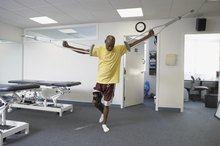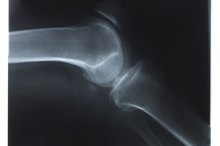The Difference Between Muscular Dystrophy and Multiple Sclerosis
Progressive muscular weakness, muscle wasting, loss of coordination, balance problems and walking difficulties are characteristics of a number of diseases. These signs and symptoms can stem from any condition that interferes with muscle function, whether it damages the muscles themselves or interrupts the nerve impulses that regulate muscle movement. Therefore, disorders that appear to cause similar symptoms, such as the muscular dystrophies and multiple sclerosis, may have completely different underlying causes. Furthermore, treatment for these conditions can be radically different.
Causes
Multiple sclerosis occurs when your immune system attacks the nerve cells in your brain and spinal cord. The damage that results from this autoimmune activity can lead to problems with vision, bowel and bladder control, sensation and muscular function. It is not clear what initially stimulates your immune system to attack your nerve cells.
Muscular dystrophies -- Duchenne, Becker, limb-girdle and others -- are inherited disorders that lead to abnormalities of specific proteins within your muscle cells. Over time, these defective proteins cause progressive loss of muscle function. Unlike multiple sclerosis, muscular dystrophy does not damage the nerves in your central nervous system. People with muscular dystrophy often have hormonal and metabolic abnormalities, such as low testosterone levels and insulin resistance.
- Multiple sclerosis occurs when your immune system attacks the nerve cells in your brain and spinal cord.
- Muscular dystrophies -- Duchenne, Becker, limb-girdle and others -- are inherited disorders that lead to abnormalities of specific proteins within your muscle cells.
Diagnostic Methods
Diseases Similar to ALS
Learn More
According to a 2011 review in the "Annals of Neurology," multiple sclerosis can be diagnosed on the basis of your symptoms and physical examination 1. If you have neurological problems that evolve over time and involve more than one body region -- doctors use the terms "disseminate in time" and "disseminate in space" -- you may have multiple sclerosis. Magnetic resonance imaging and fluid taken from your spine may be used to confirm your diagnosis.
Like multiple sclerosis, muscular dystrophies can often be diagnosed on the basis of your symptoms and physical findings. Electrical studies to evaluate muscle function, blood tests to detect muscular damage and muscle biopsies are the tests doctors typically use to confirm a diagnosis of muscular dystrophy.
- According to a 2011 review in the "Annals of Neurology," multiple sclerosis can be diagnosed on the basis of your symptoms and physical examination 1.
- Electrical studies to evaluate muscle function, blood tests to detect muscular damage and muscle biopsies are the tests doctors typically use to confirm a diagnosis of muscular dystrophy.
Treatments
A number of treatments are available for people with multiple sclerosis, most of them designed to quiet an overactive immune system. According to a 2012 review in "Neurological Disorders," some of treatments -- natalizumab (Tysabri), glatiramer (Copaxone) and fingolimod (Gilenya), for example -- target specific immune components that damage nerve cells. Other medications such as beta-interferon (Betaseron, Rebif) and corticosteroids, modify or suppress your overall immune response. Depending on the type of multiple sclerosis you have, some of these treatments may allow you to maintain a relatively normal lifestyle for several years.
No effective therapies are yet available for muscular dystrophy. Daily doses of corticosteroids may improve strength and slow progression in some types of muscular dystrophy, such as Duchenne. However, such treatment will not alter the long-term course of the disease. Physical and occupational therapy, braces and surgery help people cope with their disabilities. Gene therapy, which involves replacing the defective genes that cause muscular dystrophy with normal genes, is a promising area of research.
- A number of treatments are available for people with multiple sclerosis, most of them designed to quiet an overactive immune system.
- According to a 2012 review in "Neurological Disorders," some of treatments -- natalizumab (Tysabri), glatiramer (Copaxone) and fingolimod (Gilenya), for example -- target specific immune components that damage nerve cells.
Timelines
What Causes Muscle Loss?
Learn More
Multiple sclerosis and muscular dystrophy can present at different life stages and with varying levels of severity. Most forms of MS and certain types of muscular dystrophy, such as limb-girdle dystrophy, are relatively mild and tend to progress slowly. Advances in treatment have made it possible for most patients with MS to live a normal lifespan.
Conversely, the more severe forms of multiple sclerosis and muscular dystrophy, such as primary progressive MS and Duchenne dystrophy, can lead to death within a few years. Respiratory failure due to progressive muscle weakness is a common cause of death in people with muscular dystrophy, although heart failure and abnormal heart rhythms may also play a role. Respiratory failure and infections, such as pneumonia, may contribute to death in severe cases of MS that do not respond to treatment.
Both MS and muscular dystrophy can present in either childhood or adulthood. However, most cases of MS begin between the ages of 20 and 40, while most types of muscular dystrophy announce themselves in childhood or adolescence. In most cases, distinguishing multiple sclerosis from muscular dystrophy is straightforward.
- Multiple sclerosis and muscular dystrophy can present at different life stages and with varying levels of severity.
- Conversely, the more severe forms of multiple sclerosis and muscular dystrophy, such as primary progressive MS and Duchenne dystrophy, can lead to death within a few years.
Related Articles
References
- Neurological Disorders: Current and Emerging Therapies in Multiple Sclerosis -- A Systematic Review
- The Merck Manual of Diagnosis and Therapy, 18th Edition; Muscular Dystrophies; Mark H. Beers, M.D., Editor-in-Chief; 2006
- Journal of Clinical Neurology: Gene Therapy for Muscular Dystrophies -- Progress and Challenges
- U.S. National Library of Medicine. MedlinePlus. Muscular dystrophy
- National Institute of Neurological Disorders and Stroke. Muscular Dystrophy Information Page
- Muscular Dystrophy Association. Duchenne Muscular Dystrophy (DMD)
- Muscular Dystrophy Association. Duchenne Muscular Dystrophy (DMD). Causes/Inheritance
- Cheeran D, Khan S, Khera R, et al. Predictors of Death in Adults With Duchenne Muscular Dystrophy-Associated Cardiomyopathy. J Am Heart Assoc. 2017;6(10). doi:10.1161/JAHA.117.006340.
- Cheeran, D., et al. Predictors of Death in Adults With Duchenne Muscular Dystrophy–Associated Cardiomyopathy. Journal of the American Heart Association, 2017; 6 (10): e006340 DOI: 10.1161/JAHA.117.006340
Writer Bio
Stephen Christensen started writing health-related articles in 1976 and his work has appeared in diverse publications including professional journals, “Birds and Blooms” magazine, poetry anthologies and children's books. He received his medical degree from the University of Utah School of Medicine and completed a three-year residency in family medicine at McKay-Dee Hospital Center in Ogden, Utah.









